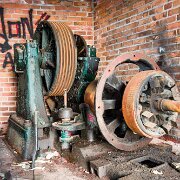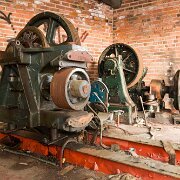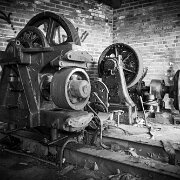
1 The Conductors Protective Association Building, Detroit Michigan
The Conductors Protective Association (CPA) Building in Detroit, completed in 1912, was an important part of the city’s early 20th-century architecture, particularly for the labor and transportation sectors. Designed in the Beaux-Arts style by the prominent architectural firm Smith, Hinchman & Grylls, the building was constructed to serve as the headquarters for the Conductors Protective Association, a fraternal organization that provided support and protection for railroad conductors. The CPA Building was a striking addition to the Detroit skyline, featuring a symmetrical façade, decorative stonework, and elegant detailing that marked the growing influence of the labor movement in the industrial heart of the United States. Located on Michigan Avenue in the heart of Detroit, it stood as a symbol of solidarity for those working in the railroad industry, which was vital to the city's economy at the time.
Throughout its history, the CPA Building served as a hub for the organization's activities and as a gathering place for railroad workers. However, as the railroad industry underwent significant changes in the mid-20th century, the building's role began to diminish. The decline of the railroads in Detroit, along with shifting economic patterns, led to a reduction in the prominence of such fraternal organizations. Despite these changes, the CPA Building remained an important architectural landmark in Detroit, representing the city’s industrial past and the labor movement that helped shape its economy. In recent years, the building has faced challenges with preservation, but its historical significance continues to resonate, particularly for those interested in Detroit’s early 20th-century labor and industrial history.
The Conductors Protective Association (CPA) Building in Detroit, completed in 1912, was an important part of the city’s early 20th-century architecture, particularly for the labor and transportation sectors. Designed in the Beaux-Arts style by the prominent architectural firm Smith, Hinchman & Grylls, the building was constructed to serve as the headquarters for the Conductors Protective Association, a fraternal organization that provided support and protection for railroad conductors. The CPA Building was a striking addition to the Detroit skyline, featuring a symmetrical façade, decorative stonework, and elegant detailing that marked the growing influence of the labor movement in the industrial heart of the United States. Located on Michigan Avenue in the heart of Detroit, it stood as a symbol of solidarity for those working in the railroad industry, which was vital to the city's economy at the time.
Throughout its history, the CPA Building served as a hub for the organization's activities and as a gathering place for railroad workers. However, as the railroad industry underwent significant changes in the mid-20th century, the building's role began to diminish. The decline of the railroads in Detroit, along with shifting economic patterns, led to a reduction in the prominence of such fraternal organizations. Despite these changes, the CPA Building remained an important architectural landmark in Detroit, representing the city’s industrial past and the labor movement that helped shape its economy. In recent years, the building has faced challenges with preservation, but its historical significance continues to resonate, particularly for those interested in Detroit’s early 20th-century labor and industrial history.

2 The Conductors Protective Association Building, Detroit Michigan
The Conductors Protective Association (CPA) Building in Detroit, completed in 1912, was an important part of the city’s early 20th-century architecture, particularly for the labor and transportation sectors. Designed in the Beaux-Arts style by the prominent architectural firm Smith, Hinchman & Grylls, the building was constructed to serve as the headquarters for the Conductors Protective Association, a fraternal organization that provided support and protection for railroad conductors. The CPA Building was a striking addition to the Detroit skyline, featuring a symmetrical façade, decorative stonework, and elegant detailing that marked the growing influence of the labor movement in the industrial heart of the United States. Located on Michigan Avenue in the heart of Detroit, it stood as a symbol of solidarity for those working in the railroad industry, which was vital to the city's economy at the time.
Throughout its history, the CPA Building served as a hub for the organization's activities and as a gathering place for railroad workers. However, as the railroad industry underwent significant changes in the mid-20th century, the building's role began to diminish. The decline of the railroads in Detroit, along with shifting economic patterns, led to a reduction in the prominence of such fraternal organizations. Despite these changes, the CPA Building remained an important architectural landmark in Detroit, representing the city’s industrial past and the labor movement that helped shape its economy. In recent years, the building has faced challenges with preservation, but its historical significance continues to resonate, particularly for those interested in Detroit’s early 20th-century labor and industrial history.
The Conductors Protective Association (CPA) Building in Detroit, completed in 1912, was an important part of the city’s early 20th-century architecture, particularly for the labor and transportation sectors. Designed in the Beaux-Arts style by the prominent architectural firm Smith, Hinchman & Grylls, the building was constructed to serve as the headquarters for the Conductors Protective Association, a fraternal organization that provided support and protection for railroad conductors. The CPA Building was a striking addition to the Detroit skyline, featuring a symmetrical façade, decorative stonework, and elegant detailing that marked the growing influence of the labor movement in the industrial heart of the United States. Located on Michigan Avenue in the heart of Detroit, it stood as a symbol of solidarity for those working in the railroad industry, which was vital to the city's economy at the time.
Throughout its history, the CPA Building served as a hub for the organization's activities and as a gathering place for railroad workers. However, as the railroad industry underwent significant changes in the mid-20th century, the building's role began to diminish. The decline of the railroads in Detroit, along with shifting economic patterns, led to a reduction in the prominence of such fraternal organizations. Despite these changes, the CPA Building remained an important architectural landmark in Detroit, representing the city’s industrial past and the labor movement that helped shape its economy. In recent years, the building has faced challenges with preservation, but its historical significance continues to resonate, particularly for those interested in Detroit’s early 20th-century labor and industrial history.

3 The Conductors Protective Association Building, Detroit Michigan
The Conductors Protective Association (CPA) Building in Detroit, completed in 1912, was an important part of the city’s early 20th-century architecture, particularly for the labor and transportation sectors. Designed in the Beaux-Arts style by the prominent architectural firm Smith, Hinchman & Grylls, the building was constructed to serve as the headquarters for the Conductors Protective Association, a fraternal organization that provided support and protection for railroad conductors. The CPA Building was a striking addition to the Detroit skyline, featuring a symmetrical façade, decorative stonework, and elegant detailing that marked the growing influence of the labor movement in the industrial heart of the United States. Located on Michigan Avenue in the heart of Detroit, it stood as a symbol of solidarity for those working in the railroad industry, which was vital to the city's economy at the time.
Throughout its history, the CPA Building served as a hub for the organization's activities and as a gathering place for railroad workers. However, as the railroad industry underwent significant changes in the mid-20th century, the building's role began to diminish. The decline of the railroads in Detroit, along with shifting economic patterns, led to a reduction in the prominence of such fraternal organizations. Despite these changes, the CPA Building remained an important architectural landmark in Detroit, representing the city’s industrial past and the labor movement that helped shape its economy. In recent years, the building has faced challenges with preservation, but its historical significance continues to resonate, particularly for those interested in Detroit’s early 20th-century labor and industrial history.
The Conductors Protective Association (CPA) Building in Detroit, completed in 1912, was an important part of the city’s early 20th-century architecture, particularly for the labor and transportation sectors. Designed in the Beaux-Arts style by the prominent architectural firm Smith, Hinchman & Grylls, the building was constructed to serve as the headquarters for the Conductors Protective Association, a fraternal organization that provided support and protection for railroad conductors. The CPA Building was a striking addition to the Detroit skyline, featuring a symmetrical façade, decorative stonework, and elegant detailing that marked the growing influence of the labor movement in the industrial heart of the United States. Located on Michigan Avenue in the heart of Detroit, it stood as a symbol of solidarity for those working in the railroad industry, which was vital to the city's economy at the time.
Throughout its history, the CPA Building served as a hub for the organization's activities and as a gathering place for railroad workers. However, as the railroad industry underwent significant changes in the mid-20th century, the building's role began to diminish. The decline of the railroads in Detroit, along with shifting economic patterns, led to a reduction in the prominence of such fraternal organizations. Despite these changes, the CPA Building remained an important architectural landmark in Detroit, representing the city’s industrial past and the labor movement that helped shape its economy. In recent years, the building has faced challenges with preservation, but its historical significance continues to resonate, particularly for those interested in Detroit’s early 20th-century labor and industrial history.

4 The Conductors Protective Association Building, Detroit Michigan
The Conductors Protective Association (CPA) Building in Detroit, completed in 1912, was an important part of the city’s early 20th-century architecture, particularly for the labor and transportation sectors. Designed in the Beaux-Arts style by the prominent architectural firm Smith, Hinchman & Grylls, the building was constructed to serve as the headquarters for the Conductors Protective Association, a fraternal organization that provided support and protection for railroad conductors. The CPA Building was a striking addition to the Detroit skyline, featuring a symmetrical façade, decorative stonework, and elegant detailing that marked the growing influence of the labor movement in the industrial heart of the United States. Located on Michigan Avenue in the heart of Detroit, it stood as a symbol of solidarity for those working in the railroad industry, which was vital to the city's economy at the time.
Throughout its history, the CPA Building served as a hub for the organization's activities and as a gathering place for railroad workers. However, as the railroad industry underwent significant changes in the mid-20th century, the building's role began to diminish. The decline of the railroads in Detroit, along with shifting economic patterns, led to a reduction in the prominence of such fraternal organizations. Despite these changes, the CPA Building remained an important architectural landmark in Detroit, representing the city’s industrial past and the labor movement that helped shape its economy. In recent years, the building has faced challenges with preservation, but its historical significance continues to resonate, particularly for those interested in Detroit’s early 20th-century labor and industrial history.
The Conductors Protective Association (CPA) Building in Detroit, completed in 1912, was an important part of the city’s early 20th-century architecture, particularly for the labor and transportation sectors. Designed in the Beaux-Arts style by the prominent architectural firm Smith, Hinchman & Grylls, the building was constructed to serve as the headquarters for the Conductors Protective Association, a fraternal organization that provided support and protection for railroad conductors. The CPA Building was a striking addition to the Detroit skyline, featuring a symmetrical façade, decorative stonework, and elegant detailing that marked the growing influence of the labor movement in the industrial heart of the United States. Located on Michigan Avenue in the heart of Detroit, it stood as a symbol of solidarity for those working in the railroad industry, which was vital to the city's economy at the time.
Throughout its history, the CPA Building served as a hub for the organization's activities and as a gathering place for railroad workers. However, as the railroad industry underwent significant changes in the mid-20th century, the building's role began to diminish. The decline of the railroads in Detroit, along with shifting economic patterns, led to a reduction in the prominence of such fraternal organizations. Despite these changes, the CPA Building remained an important architectural landmark in Detroit, representing the city’s industrial past and the labor movement that helped shape its economy. In recent years, the building has faced challenges with preservation, but its historical significance continues to resonate, particularly for those interested in Detroit’s early 20th-century labor and industrial history.

5 The Conductors Protective Association Building, Detroit Michigan
The Conductors Protective Association (CPA) Building in Detroit, completed in 1912, was an important part of the city’s early 20th-century architecture, particularly for the labor and transportation sectors. Designed in the Beaux-Arts style by the prominent architectural firm Smith, Hinchman & Grylls, the building was constructed to serve as the headquarters for the Conductors Protective Association, a fraternal organization that provided support and protection for railroad conductors. The CPA Building was a striking addition to the Detroit skyline, featuring a symmetrical façade, decorative stonework, and elegant detailing that marked the growing influence of the labor movement in the industrial heart of the United States. Located on Michigan Avenue in the heart of Detroit, it stood as a symbol of solidarity for those working in the railroad industry, which was vital to the city's economy at the time.
Throughout its history, the CPA Building served as a hub for the organization's activities and as a gathering place for railroad workers. However, as the railroad industry underwent significant changes in the mid-20th century, the building's role began to diminish. The decline of the railroads in Detroit, along with shifting economic patterns, led to a reduction in the prominence of such fraternal organizations. Despite these changes, the CPA Building remained an important architectural landmark in Detroit, representing the city’s industrial past and the labor movement that helped shape its economy. In recent years, the building has faced challenges with preservation, but its historical significance continues to resonate, particularly for those interested in Detroit’s early 20th-century labor and industrial history.
The Conductors Protective Association (CPA) Building in Detroit, completed in 1912, was an important part of the city’s early 20th-century architecture, particularly for the labor and transportation sectors. Designed in the Beaux-Arts style by the prominent architectural firm Smith, Hinchman & Grylls, the building was constructed to serve as the headquarters for the Conductors Protective Association, a fraternal organization that provided support and protection for railroad conductors. The CPA Building was a striking addition to the Detroit skyline, featuring a symmetrical façade, decorative stonework, and elegant detailing that marked the growing influence of the labor movement in the industrial heart of the United States. Located on Michigan Avenue in the heart of Detroit, it stood as a symbol of solidarity for those working in the railroad industry, which was vital to the city's economy at the time.
Throughout its history, the CPA Building served as a hub for the organization's activities and as a gathering place for railroad workers. However, as the railroad industry underwent significant changes in the mid-20th century, the building's role began to diminish. The decline of the railroads in Detroit, along with shifting economic patterns, led to a reduction in the prominence of such fraternal organizations. Despite these changes, the CPA Building remained an important architectural landmark in Detroit, representing the city’s industrial past and the labor movement that helped shape its economy. In recent years, the building has faced challenges with preservation, but its historical significance continues to resonate, particularly for those interested in Detroit’s early 20th-century labor and industrial history.
CPA Building